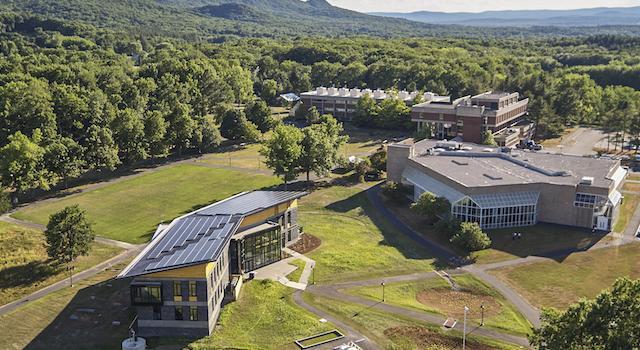Hampshire Opens Advanced Collaborative Modeling Center
Students interested in advanced modeling now have the resources of a dedicated, state-of-the-art center outfitted with lab equipment, modeling software, a 3D printer, high-definition projection screens, tablets, physical modeling accessories, and collaborative work spaces. Hampshire’s Collaborative Modeling Center opened this year in Cole Science Center, and already teams of students are using the space for collaborative projects across disciplines, while faculty are conducting workshops and teaching classes there.
“A lot of our big questions at the moment can be studied using models—there can be mathematical models, physical models, computer models,” explains Sarah Hews, one of five professors who led the opening of the center. “The CMC is a place where we can work on developing models together.”
The vibrant space is a joint project by Professors Hews, Chris Cianfrani, Megan Dobro, Cynthia Gill, and Elizabeth Conlisk. Its construction was supported by generous gifts from Lucy McFadden 70F, David Weisberg 71F, and other Hampshire alums. Additional funding came from campus renewal earmarks, bonding, and, for lighting, a grant from Greeneru, a company led by alum David Adamian 84F that collaborates with educational institutions to engineer sustainable solutions to energy and engagement challenges.
Besides the cutting-edge technology, the CMC provides a conceptual and physical space for student and faculty collaboration and scientific discussion. “We wanted a place to work with others doing science, research, and math. We wanted to bounce ideas off one another, to innovate in our teaching,” Cianfrani says. “This is an exciting place to try new ideas and work with other folks who are interested in doing that as well.”
Dobro says the center is helpful in preparing students interested in graduate school or professional lab work. The interdisciplinary environment is much closer to what students will see when they pursue an advanced degree, she says.
“They’re never going to be working in isolation in lab settings,” she says. “Nor will they be working purely in one field.”
The CMC is already helping to support a range of projects by students and faculty. Over the summer, Cianfrani and Hews led a team of first- and second-year students to the American Ecological Engineering Society Annual Meeting, where they came away with a competition’s first prize by designing the most effective storm-water filter. The team used the modeling center as a base for their research.
Recent graduate Nicole DelRosso’s Division III thesis made great use of the CMC. DelRosso studied DNA computing, a subfield of bionanotechnology that uses strands of DNA the same way a computer uses a microprocessor, enabling her to create a programmable biological entity. She did part of her Division III work in the CMC with Hews. “The CMC is a highly interdisciplinary space, something that is a uniquely Hampshire,” she says. “It’s not just math students coding; there are also microscopy students tracing cellular vesicles and organelles and students discussing their projects monitoring the Kern Center. “
CMC faculty encourage any interested students, regardless of discipline, to get in touch with them. “Just like anything at Hampshire, if you have an interest in something and you can identify the person who is involved with that, then you go talk to them,” Gill says. “Talk to us about what your interests are, and we can find opportunities for you.”
More information on the CMC is available here.
GALLERY



